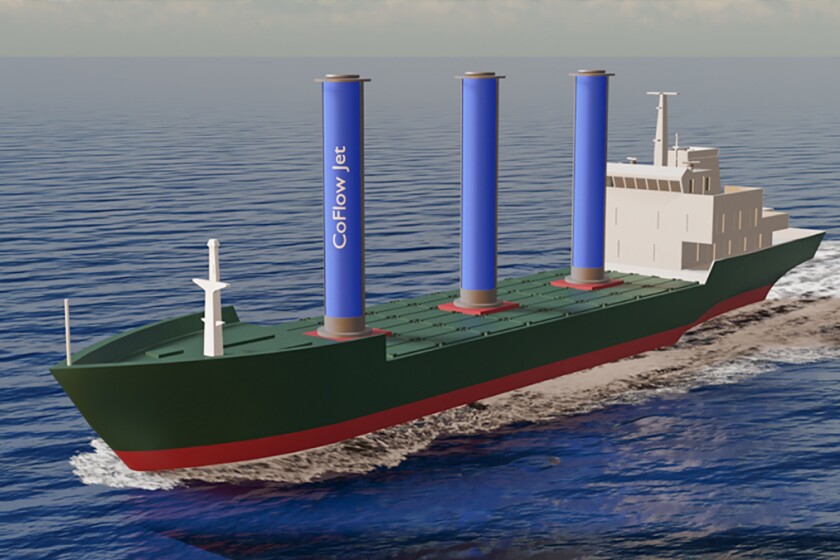
Posted on 08/02/2024 11:16:26 AM PDT by Red Badger

Artist's concept of a ship with the CoFlow system
Looking like a set of bridge supports that were accidentally installed on a cargo ship, a new wind-driven system by startup CoFlow Jet promises to reduce ship fuel costs by up to 90% using stationary cylinders with no moving parts.
Between rising fuel costs and increasing government mandates requiring shipping companies to go carbon neutral by 2050, there's a strong push to increase the efficiency of cargo ships while reducing their emissions. One way of doing this is to take a page from the history books and readopt sails to harness the wind.
On the surface, that makes sense. Sails have been propelling ships all over the world for millennia and were still used for commercial transport until after the Second World War. However, there are two problems with sails that have pushed them out of the cargo market for all except the most local of niches.
First, traditional sails require huge crews. Something the size of the 921-tonne tea clipper Cutty Sark needed a crew of about 30 to handle the sails and the complex sheets and lines that controlled them. Compare that to a modern 196,000-tonne container ship that needs only 13 officers and sailors – and most of them are pushing buttons instead of hauling lines.
The second problem is that sails are completely dependent on the wind. If the wind is blowing hard enough and in the right direction, great. If it's blowing too little or too hard, or if it's blowing from the wrong quarter, that's not so great. If it's not blowing at all, you're not going anywhere.
(Excerpt) Read more at newatlas.com ...
They think the public is quite gullible.
And if there is no wind..................................
I'm having a problem seeing how that doesn't consume as much or more power than it "saves". You know, that whole law of conservation of energy thing.
“They think the public is quite gullible.”
Why do you say that?
“And if there is no wind..................................”
And if you had read the article..........................
Storm ready?-)
like solar, this gets promoted every few years.
“I’m having a problem seeing how that doesn’t consume as much or more power than it “saves”. You know, that whole law of conservation of energy thing.”
The latest instance of a PMM - perpetual motion machine. I assume someone is sucking on the teat of government grants to push this idiocy.
“And if there is no wind..................................”
And if you had even comprehended the headline..........................
Probably cause male boxers can beat the crap out of women legally now,-)
wonder how the ship handles in rough weather and strong currents
According to Zha, this makes for a very effective wind propulsion system
Or, if there is a hell of a lot of wind like in a major typhoon or North Sea blow— what then. These don’t appear to be retractable back into the ship. Oftentimes ships have to power INTO the wave force direction to survive a storm, and not be broken in two.
Based on the tonnage of heavy things like cars that come halfway across the world to us and are competitive with our own industry, what’s the big deal about a more efficient cargo ship?
“The latest instance of a PMM - perpetual motion machine. I assume someone is sucking on the teat of government grants to push this idiocy.”
Stupid post.
“I’m having a problem seeing how that doesn’t consume as much or more power than it “saves”. You know, that whole law of conservation of energy thing.”
It doesn’t save energy. It gets energy from the motion of air molecules.
“..Probably cause male boxers can beat the crap out of women legally now,-)...”
It’s the new olympics sport: female abuse.
Hertz is ready to convert their entire fleet!
“These don’t appear to be retractable back into the ship. “
You didn’t read the article.
Disclaimer: Opinions posted on Free Republic are those of the individual posters and do not necessarily represent the opinion of Free Republic or its management. All materials posted herein are protected by copyright law and the exemption for fair use of copyrighted works.